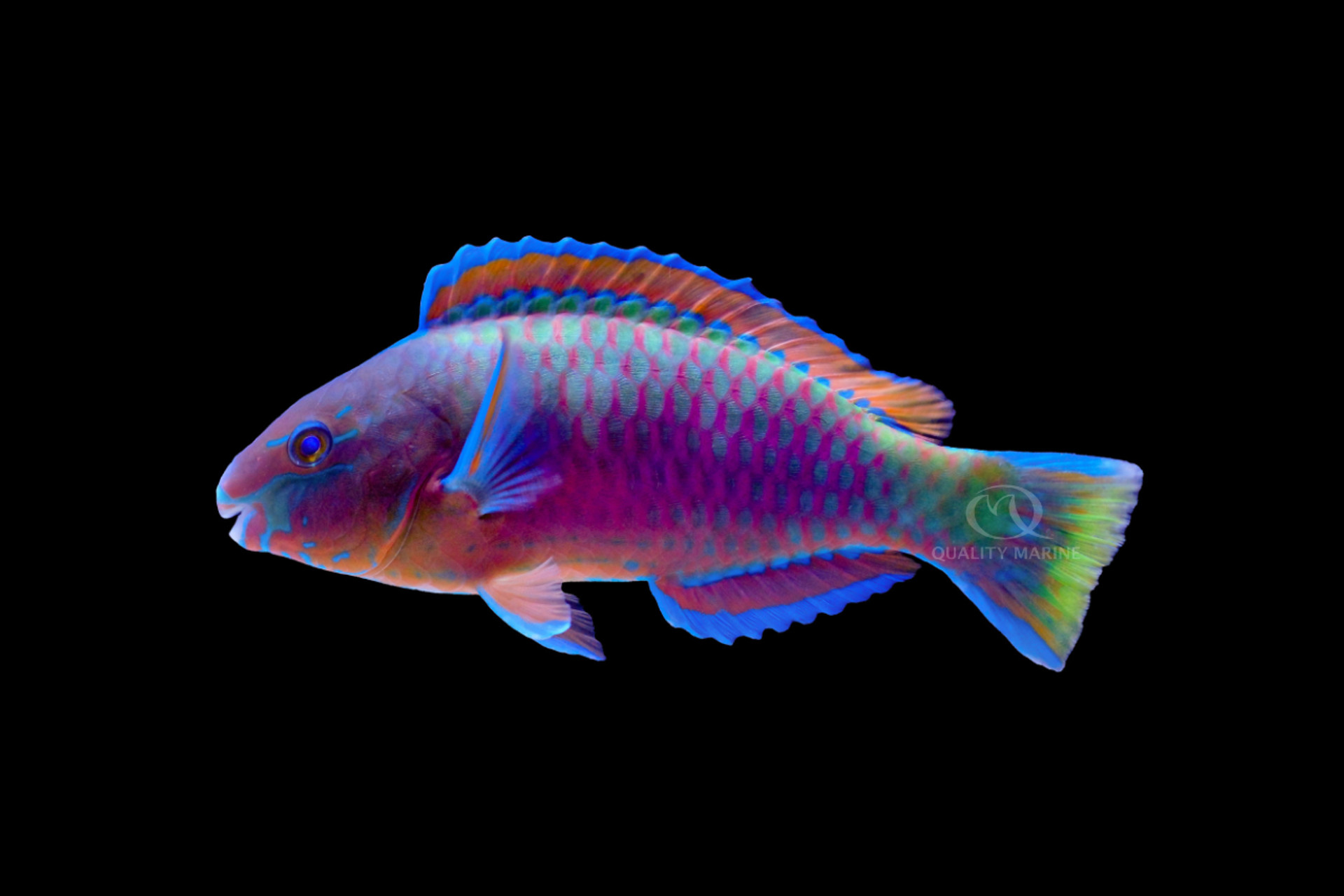It's Halloween, Let's Talk Scarus!

There are only a few English common names for Scarus quoyi: Scarus Parrotfish, Quoy's Parrotfish, and sometimes Greenblotch, or Green Blotched Parrotfish. It has tons of common names outside of the English language, including over a dozen in the Philippines alone (though to be fair, there are at least six dialects spoken there which does increase the number of names needed). Parrotfish are some of the ocean's most iconic fish, brilliantly colored, often eaten, and at least in reference to captive keeping, somewhat misunderstood.
In the wild, Scarus Parrotfish are common, as they reproduce quickly and are capable of doubling their population in 15 months. They're often found in small groups, and sometimes singly, throughout the Indian and western Pacific oceans, pretty much everywhere there is a tropical coral reef. They are also common in adjacent habitats like tidal flats and seagrass beds, anywhere there is algae to graze on. This means that in general, they live in fairly shallow water, less than 55 feet deep or so.
Scarus Parrots are not corals eaters. Instead, the subsist primarily on algae, though their mechanism for getting these algae utilizes their powerful jaws and extraordinary teeth to take bites of rock and sometimes corals to get it; they eat the algae and grind the rock with plate like teeth in the back of their throat producing a lovely soft sand that ends up on the ocean floor and adjacent beaches! In the course of this process, they also get a fair amount of bycatch, small invertebrates living in the algae and rock that is consumed, getting the fish vital protein for growth.

These very active fish need an aquarium that is fairly large, at least six feet long meaning 150 gallons or more. This will give them ample swimming space, room to grow and lots of area for grazing, all of which are important for their well-being. They will enjoy strong flow, and need good, consistent water quality, so filtration should be appropriately sized. Shoot for a system that can turn over the entire volume of the display 20 times per hour. More flow can be added with wavemakers, powerheads and other flow devices. Substrate won't matter except for its aesthetic value, so these fish are great candidates for bare bottom tanks. Because of how they graze, the more real, porous live rock you can get into this tank without compromising flow, the better.
Scarus quoyi are very peaceful, and while capable of getting fairly large, are easily bullied by aggressive or territorial tankmates, even ones much smaller than the Parrotfish! In regard to this size, adults are usually in the eight-to-ten-inch range, the largest fish on record was a hair over 15 inches long, but you're unlikely to find one this large, or even grow one to this length as they have a very slow growth rate. Keep their peaceful nature in mind when picking other fish to share a display with them. Avoid things like Damsels, Maroon Clowns, most Triggerfish, etc. Some good choices would be any kind of Cardinal, Ocellaris, Percula and Skunk Clowns, Small Wrasses like Halichoeres, Cirrhilabrus and Paracheilinus genus fish, and smaller Anthias species like Dispar or Lyretails etc. The Scarus should be the showpiece for the tank, and with its stunning looks and high activity level, it's well suited for this job.
The elephant in the room is what kind of tank to put this in. If you do a quick google search, you'll find a huge range of advice on whether Scarus Parrotfish are reef safe or not. Some people will tell you that they should never be kept with any type of coral, some will tell you they are okay with LPS, and some people will tell you this fish is completely reef safe and you have nothing to worry about! Our experience is that you should be cautious with this. Ideally, you'd put this fish into a very established display with lots of rock and algae and skip corals altogether. This will still be an amazing display. If you absolutely have to keep them with corals, we suggest going for soft corals and polyps. They are very unlikely to bother things like Mushroom Corals, Xenia, Tree Corals like Cladiella or Litophyton and Toadstools, all of which will thrive in tanks that have enough nutrients to keep a steady supply of algae growing for the Parrot. The corals with the highest risk of consumption with any Parrotfish with stony corals. These fish have evolved to take bites out of rock to harvest algae, and may not differentiate stony corals from other rock, in fact, they may prefer the stony coral as it comes packed with symbiotic algae and is usually less dense than the other rocks in an aquarium.
The best way to keep your Scarus Parrotfish from munching on anything is to make sure it is well fed. To this end, go for foods high in algae content. Nutramar's Algae and Color Boost Shots are a great nutritional balance for them and can get stuck to rock for the Parrot to graze on, which creates a natural feeding activity. They will usually take small meaty foods as well, so things like Gamma Food's spirulina loaded brine are a perfect choice. Don't over feed meaty foods as these fish can easily get too much protein in their diet which can cause them digestive issues.
If you're interested keeping one of the world's most colorful, peaceful fish in your aquarium, the Scarus Parrotfish fits this description perfectly. They are the absolute definition of showpiece fish. For those of you with a little experience keeping aquariums and if you have a large enough display, with lots of rock and other peaceful fish, this fish will be a stunningly beautiful addition for you. Head to your Local Fish Store, ask about sustainably sourced Scarus quoyi and pick up some Nutramar Algae and Color Boost Shots while you're at it!